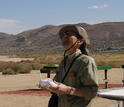EAR Annouces Staff Changes Fall 2017

New section heads and staff. Top: Anderson, Patino, Lakshmi; Bottom: Wynn, Jensen, Thomas
September 19, 2017
All good things must come to an end, like summer break between school terms. At the Division of the Earth Sciences (EAR), faces have changed, too. The Division’s staff roster has changed with one-two punches. We welcome two new section heads, two new program directors and two new science assistants. We appreciate the leadership of an acting section head, who stays on our roster, but say goodbye to two rotating program directors and two science assistants.
The division’s leadership team is now is in place with the appointment of two new section heads.
Greg Anderson was named permanent Section Head for the Division of Integrated Activities. Anderson served as acting section head since the division’s reorganization in Jan., 2017. He joined the National Science Foundation (NSF) in 2009 and has served as a program director for EarthScope; oversaw the EarthScope Facility and Southern California Earthquake Center awards; and co-chaired an NSF-wide competition for the Hazards Science, Engineering and Education for Sustainability program.
Lina Patino, the newly appointed Section Head for Disciplinary Programs, has been an NSF program director since 2005 and previously served as acting section head (2010-12). She managed the Education and Workforce Development portfolio; served as a detail in the Office of International Science and Engineering; and served on the Directorate for Geosciences Education Working Group.
Acting leadership was paramount during the Division's realignment and Committee of Visitors. We appreciate a job well done by a division program director serving on the EAR leadership team.
Eva Zanzerkia completed her duties as Acting Section Head for the Division’s Disciplinary Programs Section and returned to her program director activities. Eva led the section through the division realignment, supervised proposal processing and completed performance evaluations. She also led a division-wide Committee of Visitors review. Her tremendous service to EAR is greatly appreciated.
The Division’s program management team was recently enhanced with the addition of two new rotating experts and two new science assistants.
Venkat Lakshmi, Program Director for Hydrologic Sciences, joins EAR from the Dept. of Earth and Ocean Sciences at the Univ. of South Carolina. He serves as associate editor of the Journal of Hydrology, editor for Vadose Zone Journal and founding editor-in-chief for Remote Sensing in Earth System Science (launching 2018). His research includes hydrometeorology, hydro-climatology and land-atmospheric-ecological interactions through modeling and remote sensing.
Jonathan Wynn, Program Director for Geobiology and Low-temperature Geochemistry and Paleo Perspectives on Climate Change Programs, joins the Division’s staff from the School of Geosciences at the Univ. of South Florida. He research interests include paleodiets of early hominins in eastern African rift basins; the role of freshwater from sea-ice melt in recent acidification of the Arctic Ocean; and the fate of terrestrial carbon with land-use change in Australian tropical savannas.
Heidi Jensen, Science Assistant, earned a B.S. in Environmental Science from SUNY-Albany and M.S. in Geosciences from Stony Brook Univ. Her research focused on the distribution of halide minerals and amorphous iron sulfate characteristics on Mars—publishing on both. She also served as Executive Secretary for several review panels in NASA’s Planetary Science Division. Jensen will support program management, analytics and communications efforts for the division.
Mia Thomas, Science Assistant, earned a B.S. in Chemistry, Environmental Studies and Arts from St. Lawrence Univ. Her research includes coral reef biology at the Bermuda Inst. of Ocean Sciences; marine conservation field work at Little Cayman Research Centre; monitoring bird populations and outreach at Québec Labrador Foundation; and studying novel pain medications with Alkermes, Inc. Thomas will support program management, analytics and communications efforts for the division.
New leadership and staff members are pictured in the photo collage above. Top: Greg Anderson, Lina Patino (Leadership), Venkat Lakshmi. Bottom: Jonathan Wynn (Program Directors), Heidi Jensen, Mia Thomas (Science Assistants).
The Division is thankful for the service of two rotating program directors and program assistants completing their tenures at NSF.
Thomas Burbey returned to Virginia Tech after completing a rotator position with the Hydrologic Sciences Program. He returns to his research efforts that pertain largely to the use of stress-strain signals for characterizing aquifer properties and deep reservoirs used for carbon dioxide sequestration.
Herb Wang returned to his professorship at the University of Wisconsin-Madison Dept. of Geoscience after completing a rotator position with the Hydrologic Sciences Program. He returned to his research interests in poroelastic behavior of rocks, multiphase fluid flow in rock and geomechanical modeling.
David Domanski completed his tenure as a science assistant and is now enrolled in Johns Hopkins University’s M.S. degree program in Environmental Engineering.
Jessie Straub completed her tenure as a science assistant and started her M.S. program at the Univ. of North Carolina Inst. of Marine Science.
EAR appreciates the outstanding service of these staff members.
Subscribe to EAR updates by sending a blank email to join-earth@listserv.nsf.gov. You can unsubscribe at any time by sending an email to earth-unsubscribe-request@listserv.nsf.gov.
The U.S. National Science Foundation propels the nation forward by advancing fundamental research in all fields of science and engineering. NSF supports research and people by providing facilities, instruments and funding to support their ingenuity and sustain the U.S. as a global leader in research and innovation. With a fiscal year 2023 budget of $9.5 billion, NSF funds reach all 50 states through grants to nearly 2,000 colleges, universities and institutions. Each year, NSF receives more than 40,000 competitive proposals and makes about 11,000 new awards. Those awards include support for cooperative research with industry, Arctic and Antarctic research and operations, and U.S. participation in international scientific efforts.
Connect with us online
NSF website: nsf.gov
NSF News: nsf.gov/news
For News Media: nsf.gov/news/newsroom
Statistics: nsf.gov/statistics/
Awards database: nsf.gov/awardsearch/
Follow us on social
Twitter: twitter.com/NSF
Facebook: facebook.com/US.NSF
Instagram: instagram.com/nsfgov





